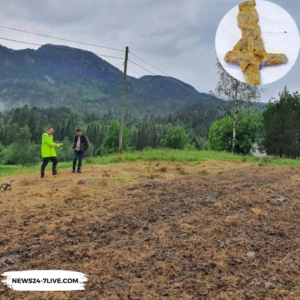The Amazon River, has a treasure trove of ancient rock carvings as its water levels have plummeted to lows. These astonishing carvings, which include human faces, animals, and intricate patterns, are estimated to be between 1,000 and 2,000 years old.

Also Read: Europe’s Oldest Shoes Found in a Spanish Bat Cave
The site of this archaeological revelation, known as Ponto das Lajes, is located on the shores of the Rio Negro in Brazil.
This archaeological marvel has captured the attention of researchers, archaeologists, and the public alike, shedding new light on the history of the indigenous peoples of the Amazon and the intricate artistry that thrived in the region.
The Amazon River, often described as the “lungs of the Earth” due to its vital role in maintaining the global ecosystem, has been experiencing a historic drought.
This drought has resulted from a combination of factors, including the El Niño weather pattern and warming in the North Atlantic associated with climate change.
These events have led to a reduction in rainfall in the northern Amazon region, resulting in the Amazon River’s water levels reaching an all-time low.
On Monday, the Rio Negro, a tributary of the Amazon River, recorded a depth of only 12.89 meters, marking the first time it has dropped below 13 meters.
This drought has exposed vast stretches of rocky riverbanks that were once submerged, revealing a treasure trove of ancient petroglyphs and rock carvings that had been hidden for centuries.
The petroglyphs uncovered at Ponto das Lajes are nothing short of an archaeological marvel. These intricate carvings offer a glimpse into the lives and cultures of the ancient inhabitants of the Amazon.
The striking among these are the human faces, each with its own unique expression, whether it be a smile or a solemn visage.
Also Read: 1,000 Year-Old ‘Alien Corpses’ Displayed at Mexico’s Congress
These faces are believed to have been carved by indigenous people who lived in the region well before the arrival of European explorers.
Archaeologist Jaime de Santana Oliveira, who played a pivotal role in bringing this discovery to the forefront, emphasizes the historical significance of these carvings.
“The engravings are prehistoric, or precolonial. We cannot date them exactly, but based on evidence of human occupation of the area, we believe they are about 1,000 to 2,000 years old,” says Oliveira.
These carvings are more than mere art; they are a tangible connection to the indigenous cultures that flourished in the heart of the Amazon long before modern civilization took root.
The petroglyphs at Ponto das Lajes are not limited to human faces alone. The exposed rock carvings also include depictions of animals and natural forms.
These artistic representations offer insights into the ancient Amazonian way of life, showcasing the connection between the indigenous peoples and their natural surroundings.
These carvings depict the rich tapestry of flora and fauna that were an integral part of daily life in the Amazon. One of the most intriguing aspects of these carvings is the presence of grooves in the rock.
These grooves are believed to have served as tools for sharpening various instruments, suggesting that the site was not only a canvas for artistic expression but also a hub for practical activities such as tool production.
Also Read: Four 1,900-Year-Old Roman Swords Found in Dead Sea Cave
Carlos Augusto da Silva of the Federal University of Amazonas has identified 25 groups of carvings on a single rock, which he believes served as a whetstone for sharpening tools.
Ponto das Lajes, aside from being an archaeological marvel, is also a testament to the vibrant history of the Amazon region.
This site was home to large indigenous villages in pre-Columbian times, and fragments of ceramics that are thought to be thousands of years old have been discovered, further highlighting the rich cultural heritage of the area.
However, it is worth noting that despite being designated as an archaeological site, Ponto das Lajes and its petroglyphs have not been thoroughly studied.
Researchers are currently estimating the age of these carvings based on similar rock art found in other parts of central Amazonia.
It is imperative that these sites, with their black soil, abundant ceramic fragments, and rock carvings, be treated with the utmost respect.
As archaeologist Filippo Stampanoni Bassi emphasized, these locations offer a window into the ancient indigenous history of the region, and it is the responsibility of all who live in Manaus today to ensure their preservation.
Also Read: British Museum: More than 1,000 Artefacts were Stolen


/cloudfront-us-east-2.images.arcpublishing.com/reuters/EPFHZ3DNAZP7PAPALWJBDGVUEY.jpg)




















